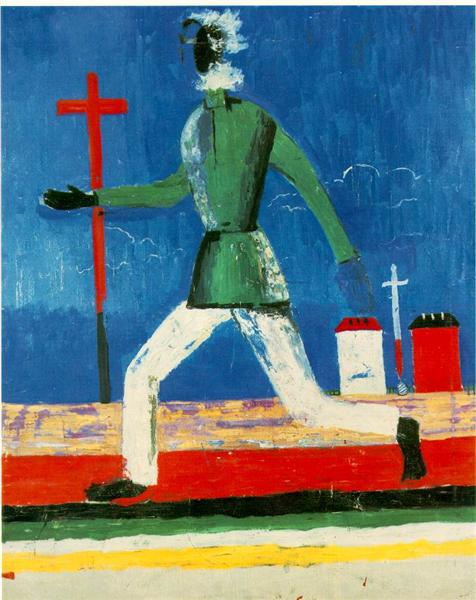Description
In the vast universe of the art of the twentieth century, few figures are as relevant and paradigmatic as that of Kazimir Malevich. This Russian artist, born in 1879, stands as one of the parents of suprematism, an artistic movement that claimed the supremacy of pure sensitivity in visual arts. One of his late works, "the man who runs" from 1933, offers a fascinating incursion into the author's artistic and philosophical ideology, and at the same time, a kind of synthesis of his stylistic evolution.
Viewing painting, an ethereal humanoid character slides in front of us, in an almost spectral movement, loaded with dynamism and kinetic energy. The figure, of clear geometric proportions, is built from tonal blocks that distribute the color in a tapestry that remembers the first explorations of abstract art. This composition reflects a partial departure from the strict principles of suprematism, introducing a certain degree of humanistic representation without completely abandoning the conceptual pillars of movement.
The use of color in "the man who runs" is notable elegance and simplification. Malevich opts for a contained palette, with predominance of blacks and blacks, which contrasts harmoniously with a few tones of red that seem to highlight the intensity of the movement. This chromatic choice could suggest a certain timelessness, a staging that transcends the merely anecdotal and enters the essence of speed and dynamism, in parallel evoking its exciting collaborations with the avant -garde of futurism.
It is important to understand the historical and personal context in which Malevich creates this work. After having lived the initial euphoria of the Russian revolution and its subsequent disappointment with the direction that art took under the Soviet regime, its production became more introspective. "The man who runs" is part of a series of paintings Where human figures, although stylized and almost abstract, begin to emerge from the canvases in a more recognizable way, as a paradoxical affirmation of humanity in a time of growing dehumanization.
The main character of the work, whose identity remains anonymous, seems to be in a perpetual state of escape or search. This perpetual movement can, on the one hand, refer to the incessant march of progress and, on the other, to the inexorable pilgrimage of the individual in his fight against oppression and conformity. The spatiality of painting, with its flattened perspective and its unique geometric shapes, is a reminiscence of the first religious icons, providing the scene with an almost mystical quality, a rite of passage in which the everyday is transmuted into the universal.
It is pertinent to mention that "the man who runs" also dialogues with the work of other contemporaries of Malevich, such as Wassily Kandinsky and Piet Mondrian, who also explored the borders between geometric abstraction and symbolic representation. Malevich, however, maintains a unique position in this dialogue, merging his faith in suprematism with a deeper exploration of the human being and his condition.
Through this work, Kazimir Malevich invites us to reflect on our own existence within a world in constant change and movement, a reflective echo of a convulsive twentieth century, but also full of potential transformations. "The man who runs" not only stands out for his plastic beauty and superb execution, but also for his ability to encapsulate and transmit the concerns of his time, projecting them towards a future that, although uncertain, remains, in many ways, a Tabula rasa for our imagination and creativity.
KUADROS ©, a famous paint on your wall.
Hand-made oil painting reproductions, with the quality of professional artists and the distinctive seal of KUADROS ©.
Art reproduction service with satisfaction guarantee. If you are not completely satisfied with the replica of your painting, we refund your money 100%.

